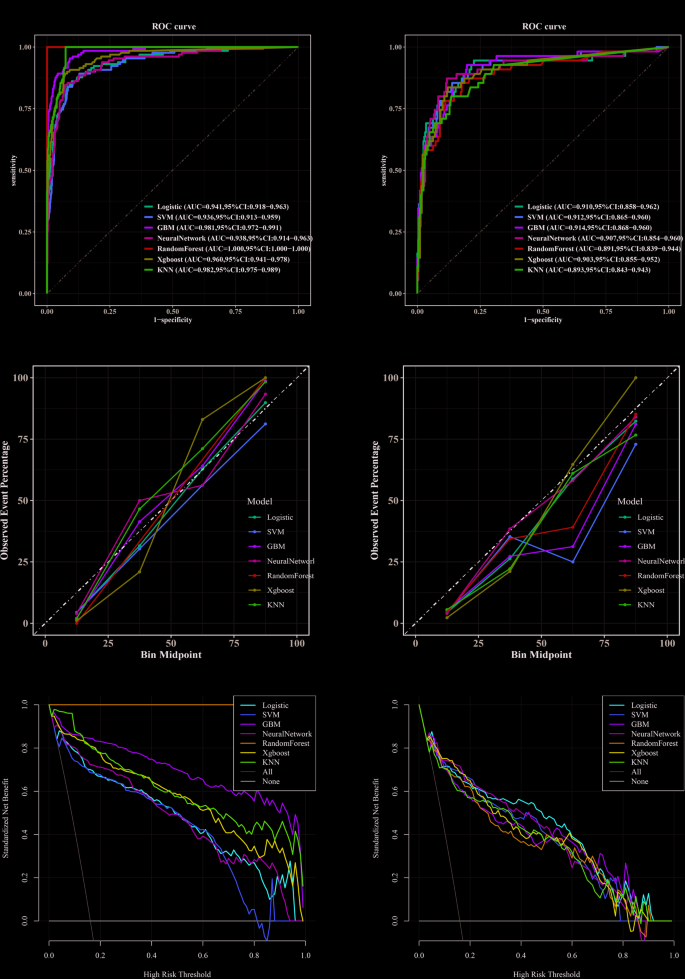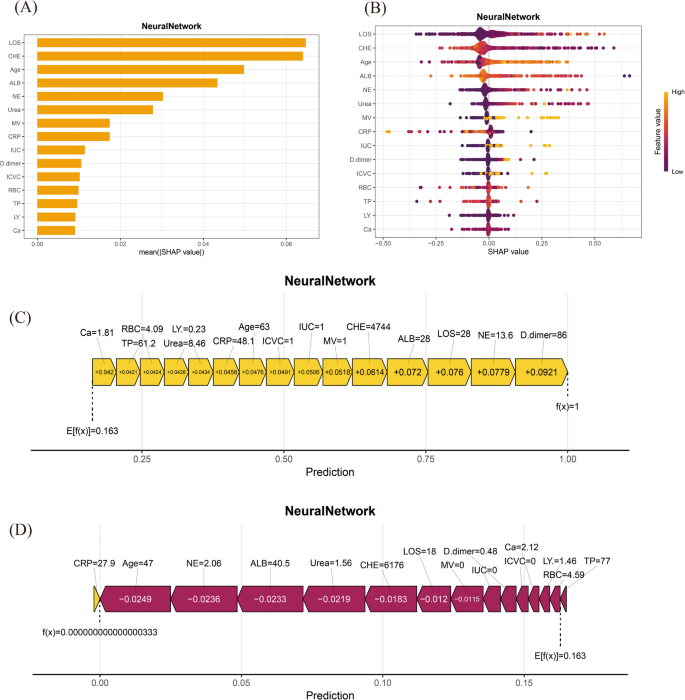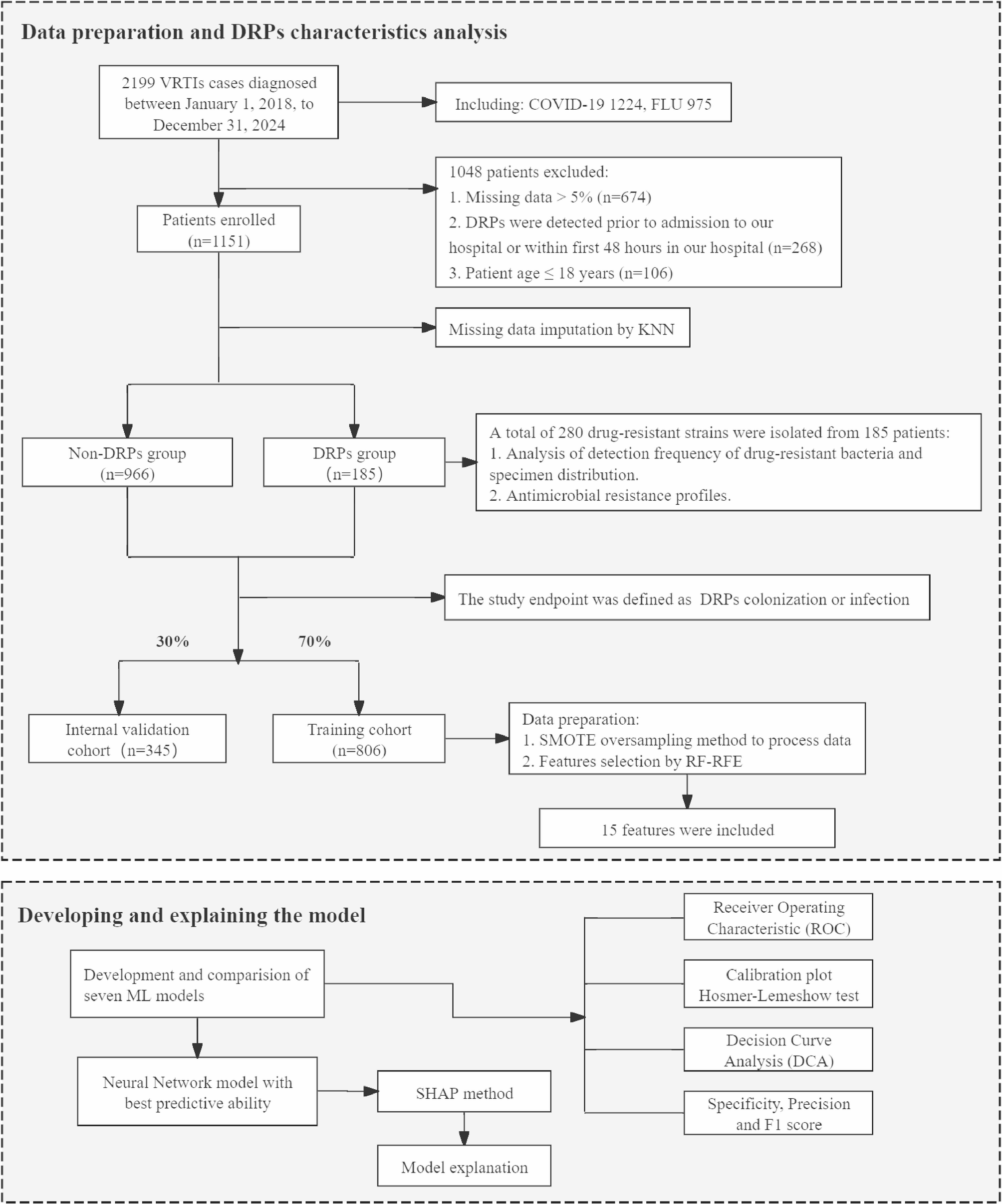Extended antibiogram of drug-resistant pathogens
Distribution characteristics of drug-resistant strains in clinical specimens
This study analyzed the distribution characteristics of bacterial pathogens in 280 clinical samples (Table 1). Gram-negative bacteria predominated significantly (75.73%), while Gram-positive bacteria accounted for only 24.27% of isolates. Specimen sources were stratified as follows: sputum (n = 183, 65.36%), followed by blood (n = 43, 15.36%), urine (n = 32, 11.43%), and BAL fluid (n = 14, 5.00%). Rare isolates were obtained from pleural effusion (n = 4, 1.43%), CVC tip (n = 2, 0.71%), and ascites (n = 2, 0.71%). The most commonly isolated microorganism from sputum was Pseudomonas aeruginosa (P. aeruginosa), from blood Staphylococcus hominis (S. hominis), from urine Escherichia coli (E. coli) and from BAL fluid Acinetobacter baumannii (A. baumannii).
Antimicrobial resistance profiles of major strains
Among 185 patients with DRPs infections, a total of 280 drug-resistant strains were isolated. The strain distribution analysis revealed the following pathogens ranked by detection frequency: P. aeruginosa (n = 46, 16.43%); Klebsiella pneumoniae (K. pneumoniae, n = 45, 16.07%); A. baumannii (n = 42, 15.00%); E. coli (n = 26, 9.29%); Stenotrophomonas maltophilia (S. maltophilia, n = 25, 8.93%) and Enterococcus faecium (E. faecium, n = 16, 5.71%).
Antibiotic resistance profiles are shown in Fig. 2. The data indicate that P. aeruginosa exhibits high resistance rates to β-lactam antibiotics such as Ceftriaxone (44/46, 95.7%), Ampicillin-Sulbactam (43/46, 93.5%), Cefotaxime (41/46, 89.1%), and Amoxicillin-Clavulanic Acid (44/46, 95.7%). It is noteworthy that among carbapenem antibiotics, except for Ertapenem (39/46, 84.8%), the resistance rates of Imipenem and Meropenem (each 21/46, 45.7%) have exceeded 45%, highlighting the need for continued clinical vigilance regarding carbapenemase prevalence trends. P. aeruginosa demonstrates high susceptibility to aminoglycosides such as Amikacin (46/46, 100%) and Tobramycin (40/46, 87%). Additionally, the pathogen retains relatively high susceptibility to certain β-lactam agents: Piperacillin-Tazobactam (30/46, 65.2%), Ceftazidime (33/46, 71.7%), and Cefepime (32/46, 69.6%). These drugs, especially Ceftazidime and Piperacillin-Tazobactam, remain clinically valuable as critical options for empirical treatment. Notably, fluoroquinolones like Ciprofloxacin (37/46, 80.4%) also exhibit favorable susceptibility.
Comparative analysis of antibiotic resistance and susceptibility profiles across clinically relevant bacterial pathogens. A. antibiotic resistance profiles of bacterial pathogens; (B). antibiotic susceptibility profiles of bacterial pathogens. cell values indicate the number of strains exhibiting resistance (A) or susceptibility (B). columns represent bacterial species, and rows list antibiotics. total isolates tested per species are shown in the “number of pathogens” row
A total of 45 K. pneumoniae isolates were analyzed, revealing alarming resistance rates to β-lactams, quinolones, and carbapenems. Among penicillins, ticarcillin (43/45, 95.6%) and ampicillin (40/45, 88.9%) exhibited the highest resistance. Resistance to cephalosporins was also prominent, with ceftriaxone, cefuroxime (each 29/45, 64.4%), and cefazolin (27/45, 60%) all exceeding 60%. For quinolones, resistance rates surpassed 50% for levofloxacin (26/45, 57.8%) and ciprofloxacin (25/45, 55.5%). Notably, carbapenems showed significantly elevated resistance rates: imipenem (24/45, 53.3%) and meropenem (21/45, 46.7%). Regarding susceptibility, K. pneumoniae displayed the highest sensitivity to sulfamethoxazole (31/45, 68.9%), followed by tigecycline (29/45, 64.4%), chloramphenicol, and amikacin (each 28/45, 62.2%). However, carbapenems such as meropenem (21/45, 46.7%) and imipenem (20/45, 44.4%) demonstrated sensitivity in only approximately half of the isolates.
A total of 42 A. baumannii isolates were analyzed, demonstrating extensive resistance to most antimicrobial agents. The bacterium exhibited extremely high resistance rates to β-lactams and β-lactam/β-lactamase inhibitor combinations, including amoxicillin-clavulanate (39/42, 92.9%), ampicillin (39/42, 92.9%), ampicillin-sulbactam (30/42, 71.4%), aztreonam (39/42, 92.9%), and amoxicillin (37/42, 88.1%). Carbapenem resistance was alarmingly high, with resistance rates of 76.2% (32/42) for imipenem, 71.4% (30/42) for meropenem, and 90.5% (38/42) for ertapenem. Among cephalosporins, resistance rates exceeded 70% for third- and fourth-generation agents: ceftriaxone (33/42, 78.6%), cefepime (32/42, 76.2%), and ceftazidime (30/42, 71.4%). Resistance to quinolones was also significant, with ciprofloxacin (32/42, 76.2%) and levofloxacin (27/42, 64.3%) showing high resistance rates. Other antibiotics, including chloramphenicol (38/42, 90.5%), trimethoprim (36/42, 85.7%), and fosfomycin (35/42, 83.3%), also demonstrated substantial resistance. In susceptibility testing, A. baumannii was most sensitive to minocycline (25/42, 59.5%). Trimethoprim-sulfamethoxazole (16/42, 38.1%) followed as the second most effective option.
This study analyzed 26 E. coli isolates, demonstrating a multidrug-resistant (MDR) trend. Among quinolones, the isolates exhibited high resistance rates to levofloxacin (14/26, 53.9%) and ciprofloxacin (12/26, 46.2%). Resistance to third-generation cephalosporins was also notable, with ceftriaxone (12/26, 46.2%) and cefuroxime (13/26, 50.0%) showing elevated resistance. Notably, aztreonam resistance reached 50.0% (13/26). For aminoglycosides, partial resistance was observed to tobramycin (10/26, 38.5%), while amikacin retained high susceptibility (20/26, 76.9%). Carbapenem susceptibility testing revealed preserved activity for both imipenem and meropenem (65.4% susceptibility rate for each, 17/26).
S. maltophilia exhibits broad-spectrum resistance to numerous clinically used antibiotics, including most β-lactams and carbapenems, resulting in extremely limited clinical therapeutic options. Antimicrobial susceptibility testing revealed high resistance rates to β-lactam antibiotics: ampicillin (25/25, 100%), amoxicillin (25/25, 100%), amoxicillin-clavulanate (25/25, 100%), cefotaxime (25/25, 100%), aztreonam (24/25, 96%), ampicillin-sulbactam (24/25, 96%), and piperacillin-tazobactam (23/25, 92%). Significant resistance was also observed to carbapenems: imipenem (24/25, 96%), meropenem (24/25, 96%), and ertapenem (23/25, 92%). Among aminoglycosides, resistance rates reached 100% for amikacin, gentamicin, and streptomycin. Notably, the highest susceptibility was observed to minocycline (25/25, 100%), followed by trimethoprim-sulfamethoxazole (23/25, 92%) and levofloxacin (16/25, 64%), while susceptibility to chloramphenicol was relatively low (11/25, 44%).
In the analysis of 16 E. faecium isolates, all strains exhibited complete resistance to clindamycin (16/16, 100%) and penicillin (16/16, 100%). Additionally, extremely high resistance rates were observed for aztreonam, trimethoprim-sulfamethoxazole, trimethoprim, fusidic acid, and polymyxin B-colistin (15/16, 93.8% for each). Notably, vancomycin (11/16, 68.8%), linezolid (13/16, 81.3%), and streptomycin (10/16, 62.5%) demonstrated higher susceptibility compared to other agents.
Hospital acquired dprs infections risk prediction via interpretable ML
Basic characteristics of patients
Of the 2199 patients diagnosed with VRTIs, 1151 patients were finally included in the statistical analysis after screening. The dataset was randomly divided into 2 parts: 70% (n = 806) of the data was used for model training, and 30% (n = 345) of the data was used for model validation. In the training cohort, 129 patients (16%) formed the DPRs group and 677 patients (84%) formed the non-DPRs group. In the validation cohort, 56 patients (16.2%) formed the DPRs group and 289 patients (83.8%) formed the non-DPRs group (Table 2).
Features selection
The RFE method combined with RF was used to select the optimal sequence of features in our study. The performance of each feature subset was assessed through 5-fold cross-validation, and the 15 features that made the model perform best were finally selected. These characteristics include ALB, MV, LOS, CHE, D-dimer, Urea, Age, IUC, LY, Ca, CRP, TP, ICVC, NE, and RBC. These variables showed the strongest association with the outcome variable, ensuring model parsimony and mitigating overfitting concerns.
Model building and evaluation
Among the seven ML models evaluated for predicting infection risk of DRPs in VRTI patients, the NN demonstrated superior overall performance. The NN achieved an AUC of 0.938 (95% CI: 0.914–0.963) in the training cohort and 0.907 (95% CI: 0.854–0.960) in the validation cohort, maintaining robust diagnostic efficacy despite not being the highest among all models (Fig. 3A, B). Validation cohort evaluations revealed that the NN model significantly outperformed other models in specificity (0.882) and precision (0.585), confirming its excellent ability to discriminate negative samples and its high positive predictive value. Furthermore, the NN attained an F1-score of 0.701, indicating an optimal balance between minimizing false positives and false negatives. The model exhibited well-matched sensitivity (0.873), reflecting balanced classification performance. In contrast, logistic regression (LR), while achieving the highest sensitivity (0.945), showed relatively lower specificity (0.775) and precision (0.444), suggesting potential overfitting or elevated false-positive rates (Table 3). The calibration curves for both the training and validation sets exhibited some degree of deviation, but remained within acceptable limits (Fig. 3C, D). DCA further confirmed the clinical utility of the NN, as it provided superior net benefit across a wide range of threshold probabilities, supporting its practical applicability in clinical settings (Fig. 3E, F).

The receiver operating characteristic (ROC) curves, calibration curves, and decision curve analysis (DCA) for both the training set and validation set. (A) ROC curves of the models in the training set. (B) ROC curves of models in the validation set. (C) Calibration curves of the models in the training set. (D) Calibration curves of the models in the validation set. (E) DCA of the models in the training set. (F) Clinical Decision Curve of the models in the validation set
Explanation of the model with the SHAP method
The SHAP algorithm is employed to determine the importance of each predictive variable in the NN model’s predictions. The included features are ranked by their mean absolute SHAP values in descending order (Figure. 4 A). The ranking from highest to lowest is as follows: LOS, CHE, Age, ALB, NE, Urea, MV, CRP, IUC, D-dimer, ICVC, RBC, TP, LY, and Ca. Additionally, to examine the positive and negative associations of predictive factors with the target outcome, we applied SHAP values to identify risk factors for hospital-acquired DPRs infection in VITRs patients, as illustrated in Figure. 4B. To demonstrate how the NN model evaluates the contributions of individual patient features, we utilize SHAP force plots to interpret individual predictions for two patients (Figure. 4 C, D). Red indicates that the feature negatively contributes to the prediction (the arrow points to the left, decreasing the SHAP value), while yellow indicates that the feature has a positive impact on the prediction (the arrow points to the right, increasing the SHAP value). The length of the color bar indicates the strength of the contribution, and E[f(x)] indicates the SHAP reference value, which is the mean predicted by the model. f(x) represents the predicted value. For patients in the “true positive” group, a predicted value (f(x)) of 1 (> reference value) indicates the presence of DPRs infection (Figure. 4 C). For patients in the “true negative” group, a predicted value (f(x)) of 0.000000000000000333 (< reference value) indicates the absence of DPRs infection or colonization (Figure. 4D).

The weights of variable importance, Shapley Additive exPlanations (SHAP) values, and SHAP force plots. (A) The weights of variables importance; (B) The Shapley Additive explanation (SHAP) values; are (C), and (D) SHAP force plor for two cases; LOS, length of stay; ALB, albumin; CHE, cholinesterase; NE, neutrophil count; MV, mechanical ventilation; CRP, C-reactive protein; IUC, indwelling urinary catheter; ICVC, indwelling central venous catheterization; RBC, red blood cell; TP, total protein; LY, lymphocyte percentage; Ca, Serum calcium
